
Pain in invertebrates
Encyclopedia
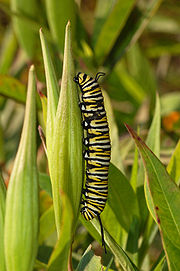
Pain
Pain is an unpleasant sensation often caused by intense or damaging stimuli such as stubbing a toe, burning a finger, putting iodine on a cut, and bumping the "funny bone."...
, almost all involve two key components. First, nociception
Nociception
Nociception is defined as "the neural processes of encoding and processing noxious stimuli." It is the afferent activity produced in the peripheral and central nervous system by stimuli that have the potential to damage tissue...
is required. This is the ability to detect noxious stimuli which evokes a reflex
Reflex
A reflex action, also known as a reflex, is an involuntary and nearly instantaneous movement in response to a stimulus. A true reflex is a behavior which is mediated via the reflex arc; this does not apply to casual uses of the term 'reflex'.-See also:...
response that moves the entire animal, or the affected part of its body, away from the source of the stimulus. The concept of nociception does not imply any adverse, subjective ‘feeling’ - it is a reflex action. The second component is the experience of ‘pain’ itself, or suffering
Suffering
Suffering, or pain in a broad sense, is an individual's basic affective experience of unpleasantness and aversion associated with harm or threat of harm. Suffering may be qualified as physical or mental. It may come in all degrees of intensity, from mild to intolerable. Factors of duration and...
, i.e. the internal, emotion
Emotion
Emotion is a complex psychophysiological experience of an individual's state of mind as interacting with biochemical and environmental influences. In humans, emotion fundamentally involves "physiological arousal, expressive behaviors, and conscious experience." Emotion is associated with mood,...
al interpretation of the nociceptive experience. Pain is therefore a private, emotional experience. We cannot currently measure pain directly in other animals, including other humans; we can measure responses to putatively painful stimuli, but not the experience itself. To address this problem when assessing the capacity of other species to experience pain, we resort to argument-by-analogy. This is based on the principle that if an animal responds to a stimulus in a similar way to ourselves, it is likely to have had an analogous experience. Dr Chris Sherwin at the University of Bristol
University of Bristol
The University of Bristol is a public research university located in Bristol, United Kingdom. One of the so-called "red brick" universities, it received its Royal Charter in 1909, although its predecessor institution, University College, Bristol, had been in existence since 1876.The University is...
used this line of reasoning to question whether invertebrates have the capacity for suffering. He argued that if we stick a pin in a chimpanzee's finger and she rapidly withdraws her hand, we use argument-by-analogy and infer that like us, she felt pain. Why then, Sherwin questions, do we not infer a cockroach experiences the same when it writhes after being stuck with a pin? This argument-by-analogy approach has been revisited by Prof. Rob Elwood at the Queen's University Belfast.
The ability to experience nociception has been subject to natural selection
Natural selection
Natural selection is the nonrandom process by which biologic traits become either more or less common in a population as a function of differential reproduction of their bearers. It is a key mechanism of evolution....
and offers an advantage to individuals with this ability as it will reduce further harm being caused to the organism. While it might be expected therefore that nociception is widespread and robust, nociception varies across species. For example, the chemical capsaicin
Capsaicin
Capsaicin 2CHCH=CH4CONHCH2C6H3-4--3- ) is the active component of chili peppers, which are plants belonging to the genus Capsicum. It is an irritant for mammals, including humans, and produces a sensation of burning in any tissue with which it comes into contact...
is commonly used as a noxious stimulus in experiments with mammals but, the African naked mole-rat, Heterocephalus glaber, an unusual rodent species that lacks pain-related neuropeptides (e.g., substance P
Substance P
In the field of neuroscience, substance P is a neuropeptide: an undecapeptide that functions as a neurotransmitter and as a neuromodulator. It belongs to the tachykinin neuropeptide family. Substance P and its closely related neuropeptide neurokinin A are produced from a polyprotein precursor...
) in cutaneous sensory fibres, shows a unique and remarkable lack of pain-related behaviours to acid and capsaicin. Similarly, capsaicin triggers nociceptors in some invertebrates, however, this substance is not noxious to Drosophila melanogaster
Drosophila melanogaster
Drosophila melanogaster is a species of Diptera, or the order of flies, in the family Drosophilidae. The species is known generally as the common fruit fly or vinegar fly. Starting from Charles W...
.
Criteria that may indicate a potential for experiencing pain include:
- Has a suitable nervous system and receptors
- Physiological changes to noxious stimuli
- Displays protective motor reactions that might include reduced use of an affected area such as limping, rubbing, holding or autotomy
- Has opioid receptors and shows reduced responses to noxious stimuli when given analgesics and local anaesthetics
- Shows trade-offs between stimulus avoidance and other motivational requirements
- Shows avoidance learning
- High cognitive ability and sentience
Central nervous system
One suggested reason for rejecting a pain experience in invertebrates is that invertebrate brains are too small. However, brain size does not necessarily equate to complexity of function. Moreover, weight for body-weight, the cephalopodCephalopod
A cephalopod is any member of the molluscan class Cephalopoda . These exclusively marine animals are characterized by bilateral body symmetry, a prominent head, and a set of arms or tentacles modified from the primitive molluscan foot...
brain is in the same size bracket as the vertebrate brain, smaller than that of birds and mammals, but as big or bigger than most fish brains.
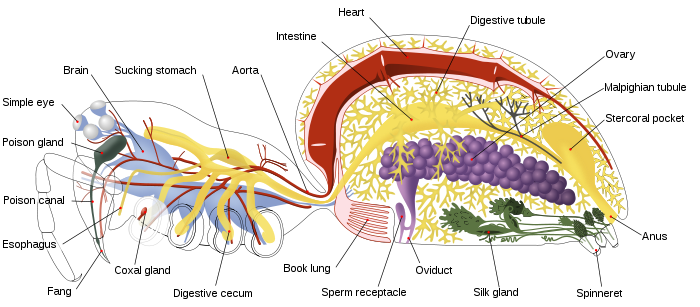
Neocortex
The neocortex , also called the neopallium and isocortex , is a part of the brain of mammals. It is the outer layer of the cerebral hemispheres, and made up of six layers, labelled I to VI...
of the brain has a central role in pain and it has been argued that any species lacking this structure will therefore be incapable of feeling pain. However, it is possible that different structures may be involved in the pain experience of other animals in the way that, for example, crustacean decapods have vision despite lacking a human visual cortex
Visual cortex
The visual cortex of the brain is the part of the cerebral cortex responsible for processing visual information. It is located in the occipital lobe, in the back of the brain....
.
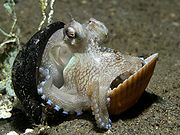
Arthropod
An arthropod is an invertebrate animal having an exoskeleton , a segmented body, and jointed appendages. Arthropods are members of the phylum Arthropoda , and include the insects, arachnids, crustaceans, and others...
s (insects, crustaceans, arachnids, and others), modern cephalopods (octopuses, squid, cuttlefish
Cuttlefish
Cuttlefish are marine animals of the order Sepiida. They belong to the class Cephalopoda . Despite their name, cuttlefish are not fish but molluscs....
) and other molluscs. The brains of arthropods and cephalopods arise from twin parallel nerve cords that extend through the body of the animal. Arthropods have a central brain with three divisions and large optical lobes behind each eye for visual processing. The brains of the modern cephalopods in particular are highly developed, comparable in complexity to the brains of some vertebrates (See also: Invertebrate brains). Emerging results suggest that a convergent evolution
Convergent evolution
Convergent evolution describes the acquisition of the same biological trait in unrelated lineages.The wing is a classic example of convergent evolution in action. Although their last common ancestor did not have wings, both birds and bats do, and are capable of powered flight. The wings are...
ary process has led to the selection of vertebrate-like neural organization and activity-dependent long-term synaptic plasticity
Synaptic plasticity
In neuroscience, synaptic plasticity is the ability of the connection, or synapse, between two neurons to change in strength in response to either use or disuse of transmission over synaptic pathways. Plastic change also results from the alteration of the number of receptors located on a synapse...
in these invertebrates. Cephalopods stand out by having a central nervous system that shares prime electrophysiological and neuroanatomical features with vertebrates like no other invertebrate taxon.
Nociceptors
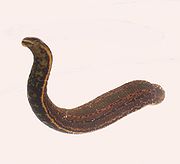
Leech
Leeches are segmented worms that belong to the phylum Annelida and comprise the subclass Hirudinea. Like other oligochaetes such as earthworms, leeches share a clitellum and are hermaphrodites. Nevertheless, they differ from other oligochaetes in significant ways...
, Hirudo medicinalis, which has the characteristic segmented body of an Annelida, each segment possessing a ganglion containing the T (touch), P (pressure) and N (noxious) cells. Later studies on the responses of leech neurones to mechanical, chemical and thermal stimulation motivated researchers to write "These properties are typical of mammalian polymodal nociceptors".
There have been numerous studies of learning and memory using nociceptors in the sea hare, Aplysia
Aplysia
Aplysia is a genus of medium-sized to extremely large sea slugs, specifically sea hares, which are one clade of large sea slugs, marine gastropod mollusks. The general description of sea hares can be found in the article on the superfamily Aplysioidea....
.
Many of these have focused on mechanosensory neurons innervating the siphon
Siphon
The word siphon is sometimes used to refer to a wide variety of devices that involve the flow of liquids through tubes. But in the English language today, the word siphon usually refers to a tube in an inverted U shape which causes a liquid to flow uphill, above the surface of the reservoir,...
and having their somata (bulbous end) in the abdominal ganglion
Ganglion
In anatomy, a ganglion is a biological tissue mass, most commonly a mass of nerve cell bodies. Cells found in a ganglion are called ganglion cells, though this term is also sometimes used to refer specifically to retinal ganglion cells....
(LE cells). These LE cells display increasing discharge to increasing pressures, with maximal activation by crushing or tearing stimuli that cause tissue injury. Therefore, they satisfy accepted definitions of nociceptors. They also show similarities to vertebrate Aδ
A delta fiber
A delta fibers, or Aδ fibers, are a type of sensory fiber.They are associated with cold and pressure, and as nociceptors stimulation of them is interpreted as fast/first pain information....
nociceptors, including a property apparently unique (among primary afferents) to nociceptors — sensitization
Sensitization
Sensitization is an example of non-associative learning in which the progressive amplification of a response follows repeated administrations of a stimulus. An everyday example of this mechanism is the repeated tonic stimulation of peripheral nerves that will occur if a person rubs his arm...
by noxious stimulation. Either pinching or pinning the siphon decreased the threshold of the LE cells firing and enhanced soma excitability.
Nociceptors have been identified in a wide range of invertebrate species, including annelids, molluscs
Mollusca
The Mollusca , common name molluscs or mollusksSpelled mollusks in the USA, see reasons given in Rosenberg's ; for the spelling mollusc see the reasons given by , is a large phylum of invertebrate animals. There are around 85,000 recognized extant species of molluscs. Mollusca is the largest...
, nematode
Nematode
The nematodes or roundworms are the most diverse phylum of pseudocoelomates, and one of the most diverse of all animals. Nematode species are very difficult to distinguish; over 28,000 have been described, of which over 16,000 are parasitic. It has been estimated that the total number of nematode...
s and arthropod
Arthropod
An arthropod is an invertebrate animal having an exoskeleton , a segmented body, and jointed appendages. Arthropods are members of the phylum Arthropoda , and include the insects, arachnids, crustaceans, and others...
s.
Physiological changes
In vertebrates, potentially painful stimuli typically produce vegetative modifications such as tachycardiaTachycardia
Tachycardia comes from the Greek words tachys and kardia . Tachycardia typically refers to a heart rate that exceeds the normal range for a resting heart rate...
, pupil dilation, defecation
Defecation
Defecation is the final act of digestion by which organisms eliminate solid, semisolid or liquid waste material from the digestive tract via the anus. Waves of muscular contraction known as peristalsis in the walls of the colon move fecal matter through the digestive tract towards the rectum...
, changes in blood flow, respiratory patterns, arteriole
Arteriole
An arteriole is a small diameter blood vessel in the microcirculation that extends and branches out from an artery and leads to capillaries.Arterioles have muscular walls and are the primary site of vascular resistance...
blood gases, fluid and electrolyte
Electrolyte
In chemistry, an electrolyte is any substance containing free ions that make the substance electrically conductive. The most typical electrolyte is an ionic solution, but molten electrolytes and solid electrolytes are also possible....
imbalance and endocrine changes.
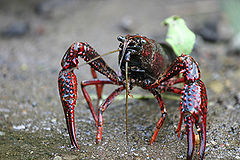
Blood cell
A blood cell, also called a hematocyte, is a cell normally found in blood. In mammals, these fall into three general categories:* red blood cells — Erythrocytes* white blood cells — Leukocytes* platelets — Thrombocytes...
(defence cells) and neuronal plasticity
Neuroplasticity
Neuroplasticity is a non-specific neuroscience term referring to the ability of the brain and nervous system in all species to change structurally and functionally as a result of input from the environment. Plasticity occurs on a variety of levels, ranging from cellular changes involved in...
, much the same as the responses of human patients undergoing surgery or after injury. In one study, heart rate in the crayfish, Procambarus clarkii
Procambarus clarkii
Procambarus clarkii is a freshwater crayfish species, native to the Southeastern United States, but found also on other continents, where it is often an invasive pest. It is known variously as the red swamp crawfish, red swamp crayfish, Louisiana crawfish, Louisiana crayfish or mudbug.-Range and...
, decreased following claw autotomy
Autotomy
Autotomy or self amputation is the act whereby an animal severs one or more of its own appendages, usually as a self-defense mechanism designed to elude a predator's grasp...
during an aggressive encounter.
Recording physiological changes in invertebrates in response to noxious stimuli will enhance the findings of behavioural observations and such studies should be encouraged. However, careful control is required because physiological changes can occur due to noxious, but non-pain related events, e.g. cardiac and respiratory activity in crustaceans is highly sensitive and responds to changes in water level, various chemicals and activity during aggressive encounters.
Protective motor reactions
Invertebrates show a wide range of protective reactions to putatively painful stimuli. However, even unicellular animals will show protective responses to, for example, extremes of temperature. Many invertebrate protective reactions appear stereotypeStereotype
A stereotype is a popular belief about specific social groups or types of individuals. The concepts of "stereotype" and "prejudice" are often confused with many other different meanings...
d and reflex
Reflex
A reflex action, also known as a reflex, is an involuntary and nearly instantaneous movement in response to a stimulus. A true reflex is a behavior which is mediated via the reflex arc; this does not apply to casual uses of the term 'reflex'.-See also:...
ive in action, perhaps indicating a nociceptive response rather than one of pain, but other responses are more plastic, especially when competing with other motivational systems (see section below), indicating a pain response analogous to that of vertebrates.
Mechanical stimulation
Rather than a simple withdrawal reflex, the flatwormFlatworm
The flatworms, known in scientific literature as Platyhelminthes or Plathelminthes are a phylum of relatively simple bilaterian, unsegmented, soft-bodied invertebrate animals...
, Notoplana aticola, displays a locomotory escape behaviour following pin pricks to the posterior end. Touching the larvae of fruit flies, D. melanogaster, with a probe causes them to pause and move away from the stimulus, however, stronger mechanical stimulation evokes a more complex corkscrew-like rolling behaviour, i.e. the response is plastic. When a weak tactile stimulus is applied to the siphon
Siphon
The word siphon is sometimes used to refer to a wide variety of devices that involve the flow of liquids through tubes. But in the English language today, the word siphon usually refers to a tube in an inverted U shape which causes a liquid to flow uphill, above the surface of the reservoir,...
of the sea-hare Aplysia californica, the animal rapidly withdraws the siphon between the parapodia. It is sometimes claimed this response is an involuntary reflex (e.g. see Aplysia gill and siphon withdrawal reflex
Aplysia gill and siphon withdrawal reflex
The Aplysia gill and siphon withdrawal reflex is an involuntary, defensive reflex of the sea hare Aplysia californica, a large shell-less sea snail or sea slug...
), however, the complex learning associated with this response (see 'Learned Avoidance' below) suggests this view might be overly simplistic.
In 2001, Walters and colleagues published a report that described the escape responses of the Tobacco Hornworm caterpillar Manduca sexta to mechanical stimulation. These responses, particularly their plasticity, were remarkably similar to vertebrate escape responses.
Autotomy
Over 200 species of invertebrates are capable of using autotomyAutotomy
Autotomy or self amputation is the act whereby an animal severs one or more of its own appendages, usually as a self-defense mechanism designed to elude a predator's grasp...
(self amputation) as an avoidance or protective behaviour including -
- land slugs (ProphysaonProphysaonProphysaon, common name taildropper slugs, is a genus of air-breathing land slugs, terrestrial pulmonate gastropod mollusks in the family Arionidae, the roundback slugs.These slugs can self-amputate a portion of their tail...
) - sea snails (Oxynoe panamensisOxynoe panamensisOxynoe panamensis is a species of small sea snail or sea slug, a bubble snail, a marine gastropod mollusk in the family Oxynoidae.-Distribution:Oxynoe panamensis is found in mangrove swamps along the Baja, California and Mexico coasts....
) - crickets
- spiders
- crabs
- lobsters
- octopusOctopusThe octopus is a cephalopod mollusc of the order Octopoda. Octopuses have two eyes and four pairs of arms, and like other cephalopods they are bilaterally symmetric. An octopus has a hard beak, with its mouth at the center point of the arms...
es
These animals can voluntarily shed appendages when necessary for survival. Autotomy can occur in response to chemical, thermal and electrical stimulation, but is perhaps most frequently a response to mechanical stimulation during capture by a predator. Autotomy serves either to improve the chances of escape or to reduce further damage occurring to the remainder of the animal such as the spread of a chemical toxin after being stung, but the 'decision' to shed a limb or part of a body and the considerable costs incurred by this, suggests a pain response rather than simply a nociceptive reflex.
Thermal stimulation
A heated probe (»42 °C or 107.6 °F) evokes a complex, corkscrew-like rolling avoidance behaviour in Drosophila larvae which occurs in as little as 0.4 seconds; a non-heated probe does not cause this avoidance behaviour. Land snails show an avoidance response to being placed on a hotplate (»40 °C or 104 °F) by lifting the anterior portion of the extended foot.Chemical stimulation
The prawnPrawn
Prawns are decapod crustaceans of the sub-order Dendrobranchiata. There are 540 extant species, in seven families, and a fossil record extending back to the Devonian...
, Palaemon elegans, shows protective motor reactions when their antennae are treated with the irritants acetic acid
Acetic acid
Acetic acid is an organic compound with the chemical formula CH3CO2H . It is a colourless liquid that when undiluted is also called glacial acetic acid. Acetic acid is the main component of vinegar , and has a distinctive sour taste and pungent smell...
or sodium hydroxide. The prawns specifically groom the treated antennae and rub them against the tank, showing they are aware of the location of the noxious stimulus on their body rather than exhibiting a generalised response to stimulation.
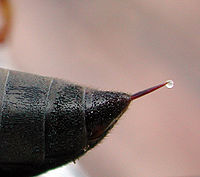
Argiope
-Greek Mythological Persons:* Argiope, a Naiad, a daughter of the River God Nile. She was wife of Agenor and mother of his children. More commonly known as Telephassa...
spp.) undergo autotomy
Autotomy
Autotomy or self amputation is the act whereby an animal severs one or more of its own appendages, usually as a self-defense mechanism designed to elude a predator's grasp...
(self-amputation) if they are stung in a leg by wasps or bees. Under experimental conditions, when spiders were injected in the leg with bee or wasp venom, they shed this appendage. But if they are injected with only saline, they rarely autotomize the leg, indicating it is not the physical insult or the ingress of fluid per se that causes autotomy. Even more interestingly, spiders injected with venom components which cause injected humans to report pain (serotonin
Serotonin
Serotonin or 5-hydroxytryptamine is a monoamine neurotransmitter. Biochemically derived from tryptophan, serotonin is primarily found in the gastrointestinal tract, platelets, and in the central nervous system of animals including humans...
, histamine
Histamine
Histamine is an organic nitrogen compound involved in local immune responses as well as regulating physiological function in the gut and acting as a neurotransmitter. Histamine triggers the inflammatory response. As part of an immune response to foreign pathogens, histamine is produced by...
, phospholipase
Phospholipase
A phospholipase is an enzyme that hydrolyzes phospholipids into fatty acids and other lipophilic substances. There are four major classes, termed A, B, C and D, distinguished by the type of reaction which they catalyze:*Phospholipase A...
A2 and melittin
Melittin
Melittin is the principal active component of apitoxin and is a powerful stimulator of phospholipase A2. Melittin is a peptide consisting of 26 amino acids with the sequence GIGAVLKVLTTGLPALISWIKRKRQQ.-Biological effects:...
) autotomize the leg, but if the injections contain venom components which do not cause pain to humans, autotomy does not occur.
Electrical stimulation
The sea-slugNudibranch
A nudibranch is a member of what is now a taxonomic clade, and what was previously a suborder, of soft-bodied, marine gastropod mollusks which shed their shell after their larval stage. They are noted for their often extraordinary colors and striking forms...
, Tritonia diomedia, possesses a group of sensory cells, "S-cells", situated in the pleural ganglia, which initiate escape swimming if stimulated by electric shock. Similarly, Mantis shrimps, Squilla mantis
Squilla mantis
Squilla mantis is a species of mantis shrimp chiefly found and fished in the Mediterranean Sea. It grows up to long, and is of the spearer type. It is generally dull brown in colouration, but has two brown eye spots, circled in white, at the base of the telson...
, show avoidance of electric shocks with a strong tail-flick escape response. Both these responses appear to be rather fixed and reflexive, however, other studies indicate a range of invertebrates exhibit considerably more plastic responses to electric shocks.
Because of their soft bodies, Hermit crab
Hermit crab
Hermit crabs are decapod crustaceans of the superfamily Paguroidea. Most of the 1100 species possess an asymmetrical abdomen which is concealed in an empty gastropod shell that is carried around by the hermit crab.-Description:...
s rely on shells for their survival, but, when they are given small electric shocks within their shells, they evacuate these. The response, however, is influenced by the attractivness of the shell; more preferred shells are only evacuated when the crabs are given a higher voltage shock, indicating this is not a simple, reflex behaviour.
In studies on learning and the Aplysia gill and siphon withdrawal reflex
Aplysia gill and siphon withdrawal reflex
The Aplysia gill and siphon withdrawal reflex is an involuntary, defensive reflex of the sea hare Aplysia californica, a large shell-less sea snail or sea slug...
, Aplysia received an electric shock on the siphon each time their gill relaxed below a criterion level. The Aplysia learned to keep their gills contracted above the criterion level - an unlikely outcome if the response was due to a nociceptive experience.
Drosophila feature widely in studies of invertebrate nociception and pain. It has been known since 1974 that these fruit-flies can be trained with sequential presentations of an odour and electric shock (odour-shock training) and will subsequently avoid the odour because it predicts something ‘bad’. A similar response has been found in the larvae of this species. In an intruiging study, Drosophila learned two kinds of prediction regarding a ‘traumatic’ experience. If an odour preceded an electric shock during training, it predicted shock and the flies subsequently avoided it. When the sequence of events during training was reversed, i.e. odour followed shock, the odour predicted relief from shock and flies approached it. The authors termed this latter effect 'relief' learning.
Many invertebrate species learn to withdraw from, or alter their behaviour in response to, a conditioned stimulus when this has been previously paired with an electric shock - cited by Sherwin - and include snails, leeches, locusts, bees and various marine molluscs.
If vertebrate species are used in studies on protective or motor behaviour and they respond in similar ways to those described above, it is usually assumed that the learning process is based on the animal experiencing a sensation of pain or discomfort from the stimulus, e.g. an electric shock. Argument-by-analogy suggests an analogous experience occurs in invertebrates.
Opioid receptors, effects of local anaesthetics or analgesics
In vertebrates, opiates modulate nociception and opioid receptorOpioid receptor
Opioid receptors are a group of G protein-coupled receptors with opioids as ligands. The endogenous opioids are dynorphins, enkephalins, endorphins, endomorphins and nociceptin. The opioid receptors are ~40% identical to somatostatin receptors...
antagonists, e.g. naloxone
Naloxone
Naloxone is an opioid antagonist drug developed by Sankyo in the 1960s. Naloxone is a drug used to counter the effects of opiate overdose, for example heroin or morphine overdose. Naloxone is specifically used to counteract life-threatening depression of the central nervous system and respiratory...
and CTOP, reverse this effect. So, if opiates have similar effects in invertebrates as vertebrates, they should delay or reduce any protective response and the opioid antagonist should counteract this. It has been found that molluscs and insects have opioid binding sites or opioid general sensitivity. Certainly there are many examples of neuropeptides involved in vertebrate pain responses being found in invertebrates, for example, endorphins have been found in platyhelminthes, molluscs, annelids, crustaceans and insects (see). It should be noted, however, that apart from analgesia, there are other effects of exogenous opiates specifically being involved in feeding behaviour and activation of immunocytes. These latter functions might explain the presence of opioids and opioid receptors in extremely simple invertebrates and unicellular animals.
Nematodes

Caenorhabditis elegans
Caenorhabditis elegans is a free-living, transparent nematode , about 1 mm in length, which lives in temperate soil environments. Research into the molecular and developmental biology of C. elegans was begun in 1974 by Sydney Brenner and it has since been used extensively as a model...
, 76% of a non-treated group exhibited a rapid, reflexive withdrawal to heat, whereas 47%, 36% and 39% of morphine, endomorphin 1 and endomorphin 2 treated worms (respectively) withdrew. These effects were reversed with the opioid receptor antagonists naloxone and CTOP, leading the authors to conclude that thermonocifensive behaviour in C. elegans was modulated by opioids.
Molluscs

Crustaceans
Evidence of the capacity for invertebrates to experience nociception and pain has been widely studied in crustaceans. In the crabCrab
True crabs are decapod crustaceans of the infraorder Brachyura, which typically have a very short projecting "tail" , or where the reduced abdomen is entirely hidden under the thorax...
Chasmagnathus granulatus, electric shocks delivered via small holes in the carapace
Carapace
A carapace is a dorsal section of the exoskeleton or shell in a number of animal groups, including arthropods such as crustaceans and arachnids, as well as vertebrates such as turtles and tortoises. In turtles and tortoises, the underside is called the plastron.-Crustaceans:In crustaceans, the...
elicited a defensive threat display. Injection of morphine reduced the crabs’ sensitivity to the shock in a dose-dependent manner, with the effect declining with increasing duration between morphine injection and shock. Naloxone injection inhibited the effects of morphine, as is seen in vertebrates. Morphine also had inhibitory effects on the escape tail-flick response to electric shock in the mantis shrimp, Squilla mantis
Squilla mantis
Squilla mantis is a species of mantis shrimp chiefly found and fished in the Mediterranean Sea. It grows up to long, and is of the spearer type. It is generally dull brown in colouration, but has two brown eye spots, circled in white, at the base of the telson...
, that was reversed by naloxone, indicating that the effect is found in crustacean groups other than decapods. When the irritants acetic acid
Acetic acid
Acetic acid is an organic compound with the chemical formula CH3CO2H . It is a colourless liquid that when undiluted is also called glacial acetic acid. Acetic acid is the main component of vinegar , and has a distinctive sour taste and pungent smell...
or sodium hydroxide were applied to the antennae of Grass prawns, Penaeus monodon
Penaeus monodon
Penaeus monodon, the giant tiger prawn , is a marine crustacean that is widely reared for food.-Distribution:...
, there was an increase in rubbing and grooming of the treated areas which was not seen if they had previously been treated with a local anaesthetic, benzocaine
Benzocaine
Benzocaine is a local anesthetic commonly used as a topical pain reliever, or in cough drops. It is the active ingredient in many over-the-counter anesthetic ointments...
, however, the benzocaine did not eliminate the level of rubbing seen in response to mechanical stimulation with forceps. There was no effect of benzocaine on the general locomotion of the prawns, so the reduction in rubbing and grooming was not simply due to inactivity of the animal. Another local anaesthetic, xylocaine, reduced the stress of eyestalk ablation in female Whiteleg shrimps, Litopenaeus vannamei, as indicated by levels of feeding and swimming.
It has not always been possible to replicate these findings in crustaceans. In one study, three decapod crustacean species, Louisiana red swamp crayfish
Procambarus clarkii
Procambarus clarkii is a freshwater crayfish species, native to the Southeastern United States, but found also on other continents, where it is often an invasive pest. It is known variously as the red swamp crawfish, red swamp crayfish, Louisiana crawfish, Louisiana crayfish or mudbug.-Range and...
, white shrimp and grass shrimp
Palaemonetes
The genus Palaemonetes includes a geographically diverse group of fresh and brackish-water shrimp. It includes the following species:*Palaemonetes africanus Balss, 1916*Palaemonetes antennarius The genus Palaemonetes includes a geographically diverse group of fresh and brackish-water shrimp. It...
were tested for nociceptive behaviour by applying sodium hydroxide, hydrochloric acid
Hydrochloric acid
Hydrochloric acid is a solution of hydrogen chloride in water, that is a highly corrosive, strong mineral acid with many industrial uses. It is found naturally in gastric acid....
, or benzocaine to the antennae. This caused no change in behaviour in these three species compared to controls. Animals did not groom the treated antenna, and there was no difference in movement of treated individuals and controls. Extracellular recordings of antennal nerves in the Louisiana red swamp crayfish revealed continual spontaneous activity, but no neurons that were reliably excited by the application of sodium hydroxide or hydrochloric acid. The authors concluded there was no behavioural or physiological evidence that the antennae contained specialized nociceptors that responded to pH. It could be argued that differences in the findings between studies may be due to responses to extreme pH being inconsistently evoked across species.
It has been argued that the analgesic effects of morphine should not be used as a criterion of the ability of animals, at least crustaceans, to experience pain. In one study, Shore crabs, Carcinus maenas
Carcinus maenas
Carcinus maenas is a common littoral crab, and an important invasive species, listed among the 100 "world's worst alien invasive species". It is native to the north-east Atlantic Ocean and Baltic Sea, but has colonised similar habitats in Australia, South Africa, South America and both Atlantic and...
received electric shocks in a preferred dark shelter but not if they remained in an unpreferred light area. Analgesia from morphine should have enhanced movement to the preferred dark area because the crabs would not have experienced ‘pain’ from the electric shock. However, morphine inhibited rather than enhanced this movement, even when no shock was given. Morphine produced a general effect of non-responsiveness rather than a specific analgesic effect, which could also explain previous studies claiming analgesia. However, the researchers argued that other systems such as the enkephalin
Enkephalin
An enkephalin is a pentapeptide involved in regulating nociception in the body. The enkephalins are termed endogenous ligands, or specifically endorphins, as they are internally derived and bind to the body's opioid receptors. Discovered in 1975, two forms of enkephalin were revealed, one...
or steroid
Steroid
A steroid is a type of organic compound that contains a characteristic arrangement of four cycloalkane rings that are joined to each other. Examples of steroids include the dietary fat cholesterol, the sex hormones estradiol and testosterone, and the anti-inflammatory drug dexamethasone.The core...
systems might be used in pain modulation by crustaceans and that behavioural responses should be considered rather than specific physiological and morphological features.
Insects

Cricket (insect)
Crickets, family Gryllidae , are insects somewhat related to grasshoppers, and more closely related to katydids or bush crickets . They have somewhat flattened bodies and long antennae. There are about 900 species of crickets...
avoided the heated surface of a hotplate.
Trade-offs between stimulus avoidance and other motivational requirements
This is a particularly important criterion for assessing whether an animal has the capacity to experience pain rather than only nociception. Nociceptive responses do not require consciousness or higher neural processing; this results in relatively fixed, reflexive actions. However, the experience of pain does involve higher neural centres which also take into account other factors of relevance to the animal, i.e. competing motivations. This means that a response to the experience of pain is likely to be more plastic than a nociceptive response when there are competing factors for the animal to consider.
Hermit crab
Hermit crabs are decapod crustaceans of the superfamily Paguroidea. Most of the 1100 species possess an asymmetrical abdomen which is concealed in an empty gastropod shell that is carried around by the hermit crab.-Description:...
s small electric shocks within their shells. Only crabs given shocks evacuated their shells indicating the aversive nature of the stimulus, but fewer crabs evacuated from a preferred species of shell demonstrating a motivational trade-off. Most crabs, however, did not evacuate at the shock level used, but when these shocked crabs were subsequently offered a new shell, they were more likely to approach and enter the new shell. They approached the new shell more quickly, investigated it for a shorter time and used fewer cheliped probes within the aperture prior to moving in. This demonstrates the experience of the electric shock altered future behaviour in a manner consistent with a marked shift in motivation to get a new shell to replace the one previously occupied.
Learned avoidance
Learning to avoid a noxious stimulus indicates that prior experience of the stimulus is remembered by the animal and appropriate action taken in the future to avoid or rduce potential damage. This type of response is therefore not the fixed, reflexive action of nociceptive avoidance.Habituation and sensitization
HabituationHabituation
Habituation can be defined as a process or as a procedure. As a process it is defined as a decrease in an elicited behavior resulting from the repeated presentation of an eliciting stimulus...
and sensitisation are two simple, but widespread, forms of learning. Habituation refers to a type of non-associative learning in which repeated exposure to a stimulus leads to decreased responding. Sensitization is another form of learning in which the progressive amplification of a response follows repeated administrations of a stimulus.
When a tactile stimulus is applied to the skin of Aplysia californica, the animal withdraws the siphon
Siphon
The word siphon is sometimes used to refer to a wide variety of devices that involve the flow of liquids through tubes. But in the English language today, the word siphon usually refers to a tube in an inverted U shape which causes a liquid to flow uphill, above the surface of the reservoir,...
and gill
Gill
A gill is a respiratory organ found in many aquatic organisms that extracts dissolved oxygen from water, afterward excreting carbon dioxide. The gills of some species such as hermit crabs have adapted to allow respiration on land provided they are kept moist...
between the parapodia. This defensive withdrawal, known as the Aplysia gill and siphon withdrawal reflex
Aplysia gill and siphon withdrawal reflex
The Aplysia gill and siphon withdrawal reflex is an involuntary, defensive reflex of the sea hare Aplysia californica, a large shell-less sea snail or sea slug...
, has been the subject of much study on learning behaviour. Generally, these studies have involved only weak, tactile stimulation and are therefore more relevant to the question of whether invertebrates can experience nociception, however, some studies have used electric shocks to examine this response (See sections on "Electrical stimulation" and "Operant conditioning").
Location avoidance
Avoidance learning was examined in the crab, Chasmagnathus granulatus, by placing the animals in a the dark compartment of a double-chamber device and allowing them to move towards a light compartment. Experimental crabs received a shock in the light compartment, whilst controls did not. After 1 min, both experimental and control crabs were free to return to the dark compartment. The learned outcome was not a faster escape response to the stimulus but rather refraining from re-entering the light compartment. A single trial was enough to establish an association between light and shock that was detected up to 3 hours later.Studies on crayfish, Procambarus clarkia, demonstrated that they learned to associate the turning on of a light with a shock that was given 10 seconds later. They learned to respond by walking to a safe area in which the shock was not delivered. However, this only occurred if the crayfish were facing the area to which they could retreat to avoid the shock. If they were facing away from the safe area the animal did not walk but responded to the shock by a tail-flick escape response. Despite repeated pairings of light and shock the animals did not learn to avoid the shock by tail-flicking in response to light. Curiously, when the animals that had experienced shocks whilst facing away from the safe area were subsequently tested facing towards the safe area they showed a very rapid avoidance of the shock upon the onset of the light. Thus, they seemed to have learned the association although they had not previously used it to avoid the shock - much like mammalian latent learning
Latent learning
Latent learning is a form of learning that is not immediately expressed in an overt response; it occurs without obvious reinforcement to be applied later....
. These studies show an ability in decapods that fulfils several criteria for pain experience rather than nociception.
Conditioned suppression
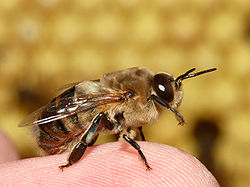
Proboscis
A proboscis is an elongated appendage from the head of an animal, either a vertebrate or an invertebrate. In simpler terms, a proboscis is the straw-like mouth found in several varieties of species.-Etymology:...
when learning about novel odours. In one study on this response, bees learnt to discriminate between two odours, but then learned to suppress the proboscis extension response when one of the odours was paired with an electric shock. This indicates the sensation was aversive to the bee, however, the response was plastic rather than simply reflexive, indicating pain rather than nociception.
Operant conditioning
Operant studiesOperant conditioning
Operant conditioning is a form of psychological learning during which an individual modifies the occurrence and form of its own behavior due to the association of the behavior with a stimulus...
using vertebrates have been conducted for many years. In such studies, an animal operates or changes some part of the environment to gain a positive reinforcement
Reinforcement
Reinforcement is a term in operant conditioning and behavior analysis for the process of increasing the rate or probability of a behavior in the form of a "response" by the delivery or emergence of a stimulus Reinforcement is a term in operant conditioning and behavior analysis for the process of...
or avoid a negative one. In this way, animals learn from the consequence of their own actions, i.e. they use an internal predictor. Operant responses indicate a voluntary act; the animal exerts control over the frequency or intensity of its responses, making these distinct from reflexes and complex fixed action pattern
Fixed action pattern
In ethology, a fixed action pattern , or modal action pattern, is an instinctive behavioral sequence that is indivisible and runs to completion...
s. A number of studies have revealed surprising similarities between vertebrates and invertebrates in their capacity to use operant responses to gain positive reinforcements, but also to avoid negative reinforcement that in vertebrates we would describe as 'pain'.
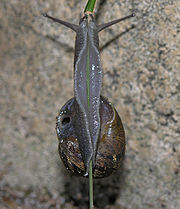
Snail
It has been shown that snails will operate a manipulandum to electrically self-stimulate areas of their brain. Balaban and Maksimova surgically implanted fine wire electrodes in two regions of the brains of snails (Helix sp.). To receive electrical stimulation of the brain, the snail was required to displace the end of a rod. When pressing the rod delivered self-stimulation to the mesocerebrum (which is involved in sexual activity) the snails increased the frequency of operating the manipulandum compared to the baseline spontaneous frequency of operation. However, when stimulation was delivered to the parietalParietal
Parietal may refer to:*Parietal placentation*Parietal lobe of the brain*Parietal bone of the skull*Parietal scales of a snake lie in the general region of the parietal bone*Parietal cell in the stomach*Parietal pleura...
ganglion, the snails decreased the frequency of touching the rod compared to the baseline spontaneous frequency. These increases and decreases in pressing are positive and negative reinforcement responses typical of those seen with vertebrates.
Aplysia
To examine the gill and siphon withdrawal response to a putatively painful stmulus, Aplysia were tested in pairs. During the initial training period, the experimental animal received a siphon shock each time its gill relaxed below a criterion level, and the yoked control animal received a shock whenever the experimental animal did, regardless of its own gill position. The experimental animals spent more time with their gills contracted above the criterion level than did the control animals during each period, demonstrating operant conditioning..jpg)
Drosophila
A fly-controlled heat-box has been designed to study operant conditioning in several studies of Drosophila. Each time a fly walks into the designated half of the tiny dark chamber, the whole space is heated. As soon as the animal leaves the punished half, the chamber temperature reverts to normal. After a few minutes, the animals restrict their movements to one-half of the chamber, even if the heat is switched off.A Drosophila flight simulator has been used to examine operant conditioning. The flies are tethered in an apparatus that measures the yaw
Yaw
The word yaw can refer to:* Yaw angle, one of the Tait-Bryan angles, describing the heading of a vehicle or machine, and some other related elements:**Yaw system, component responsible for the orientation of a wind turbine towards the wind....
torque of their flight attempts and stabilizes movements of the panorama. The apparatus controls the fly's orientation based on these attempts. When the apparatus was set up to direct a heat beam on the fly if it "flew" to certain areas of its panorama, the flies learned to prefer and avoid certain flight orientations in relation to the surrounding panorama. The flies "avoided" areas that caused them to receive heat.
These experiments show that Drosophila can use operant behaviour and learn to avoid noxious stimuli. However, these responses were plastic, complex behaviours rather than simple reflex actions, consistent more with the experience of pain rather than simply nociception.
Cognitive abilities
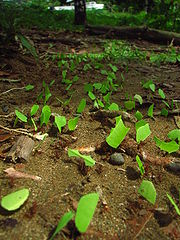
- Social transmissionSocial learningSocial learning may refer to:* Observational learning , learning that occurs as a function of observing, retaining and replicating behavior observed in ones environment or other people....
of information during the waggle danceWaggle danceWaggle dance is a term used in beekeeping and ethology for a particular figure-eight dance of the honey bee. By performing this dance, successful foragers can share with their hive mates information about the direction and distance to patches of flowers yielding nectar and pollen, to water...
of honeybeesHoney beeHoney bees are a subset of bees in the genus Apis, primarily distinguished by the production and storage of honey and the construction of perennial, colonial nests out of wax. Honey bees are the only extant members of the tribe Apini, all in the genus Apis...
. - IdiotheticIdiotheticIdiothetic literally means "self-proposition" , and is used in navigation models as in the phrase "idiothetic cues" to indicate that path integration was used to determine the present location instead of allothetic, or external, cues...
orientation by spiders, i.e. they memorize information about their previous movements.
- Detour behaviour in which spiders choose to take an indirect route to a goal rather than the most direct route, thereby indicating flexibility in behaviour and route planning, and possibly insight learning.
- ConceptConceptThe word concept is used in ordinary language as well as in almost all academic disciplines. Particularly in philosophy, psychology and cognitive sciences the term is much used and much discussed. WordNet defines concept: "conception, construct ". However, the meaning of the term concept is much...
ualisation in the honeybee, Apis mellifera.
- Problem solvingProblem solvingProblem solving is a mental process and is part of the larger problem process that includes problem finding and problem shaping. Consideredthe most complex of all intellectual functions, problem solving has been defined as higher-order cognitive process that requires the modulation and control of...
in leafcutter ants, Atta colombicaAtta colombicaAtta colombica is one of 41 species of leafcutter ant. This species is part of the Attini tribe .-Description:Workers of this species are maroon in colour, and are entirely matte, with no shiny spots.-Distribution:...
.
- NumeracyNumeracyNumeracy is the ability to reason with numbers and other mathematical concepts. A numerically literate person can manage and respond to the mathematical demands of life...
in the yellow mealworm beetle, Tenebrio molitor, and honeybee.
See also
- Animal cognitionAnimal cognitionAnimal cognition is the title given to the study of the mental capacities of non-human animals. It has developed out of comparative psychology, but has also been strongly influenced by the approach of ethology, behavioral ecology, and evolutionary psychology...
- Animal ethicsAnimal ethicsAnimal ethics can refer to:*Abolitionism *Animal law*Animal rights*Animal welfare*Intrinsic value *Wildlife managementSee also*Animal rights movement*Animal testing*Animal testing regulations*Cruelty to animals...
- Cruelty to animalsCruelty to animalsCruelty to animals, also called animal abuse or animal neglect, is the infliction of suffering or harm upon non-human animals, for purposes other than self-defense. More narrowly, it can be harm for specific gain, such as killing animals for food or for their fur, although opinions differ with...
- Emotion in animalsEmotion in animalsThere is no scientific consensus on emotion in animals, that is, what emotions certain species of animals, including humans, feel. The debate concerns primarily mammals and birds, although emotions have also been postulated for other vertebrates and even for some invertebrates.Animal lovers,...
- Pain in animalsPain in animalsPain is a sensory and emotional experience often caused by intense or damaging stimuli. The International Association for the Study of Pain says pain is a conscious experience involving unpleasantness, i.e. suffering...
- Pain in crustaceansPain in crustaceansThe question of whether or not crustaceans can experience pain is unresolved. Because of the ambiguous nature of pain, most people who contend that crustaceans do have this capacity approach the issue using 'argument by analogy' – that is, they hold that certain similarities between crustacean and...
- Pain in fishPain in fishThe presence of pain in an animal, or another human for that matter, cannot be known for sure, but the possibility that animals experience pain can be inferred through comparative brain physiology and physical and behavioral reactions...
- Pain and suffering in laboratory animals
- SentienceSentienceSentience is the ability to feel, perceive or be conscious, or to have subjective experiences. Eighteenth century philosophers used the concept to distinguish the ability to think from the ability to feel . In modern western philosophy, sentience is the ability to have sensations or experiences...

